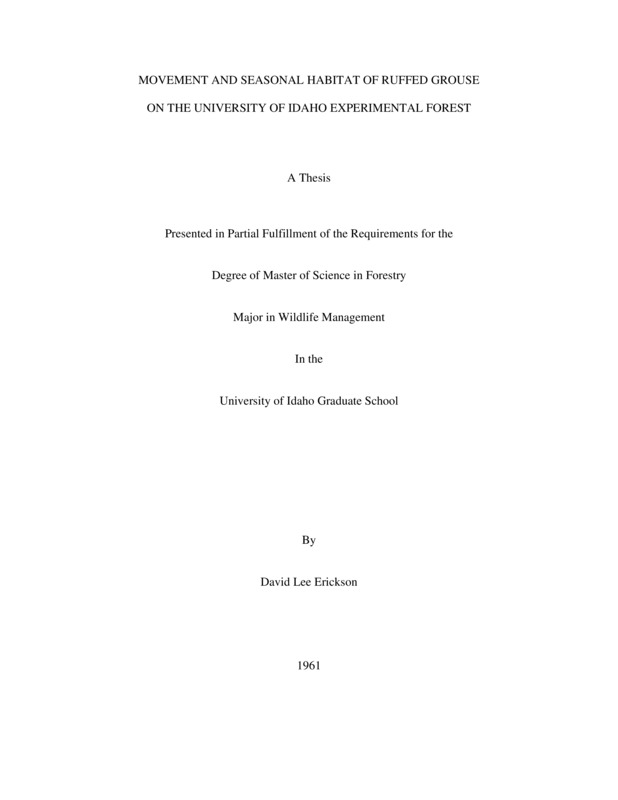PDF PREVIEW
Movement and Seasonal Habitat of Ruffed Grouse on the University of Idaho Experimental Forest Item Info
Download Preview PDF
Please note: PDF file may not be complete document.
- Title:
- Movement and Seasonal Habitat of Ruffed Grouse on the University of Idaho Experimental Forest
- Creator:
- Erickson, David Lee
- Date Created:
- 1961
- Description:
- A study of the seasonal habitat and movements of ruffed grouse was carried on during the period of June, 1959 to June, 1960. The site of investigation was an area of cut-over forest on the Flat Creek Block of the University of Idaho Experimental Forest, Latah County, Idaho. During late June and early July, ruffed grouse were found in both the Cedar-hemlock and Douglas fir zones. As the summer advanced, broods moved to the ravines during the day. Logging roads and railroad grades were used as evening feeding areas from about mid-august until at least mid-November. In the summer and fall of 1959, twenty-four grouse were banded. Six out of twenty grouse killed during the hunting season on the Flat Creek area were banded. The total kill represented about 13 percent of the fall population on the area. The banded juvenile grouse moved a maximum distance of 0.29 miles and a minimum distance of 0.04 miles in fall dispersal. The short period of time from the date of banding to the date the bird was killed or observed suggested that the dispersal distances were minimized. Although sufficient data are lacking, juvenile females moved farther than males. In addition, there was a tendency of the birds to move in a southerly direction up the major drainage system of the area. Grouse were found using the spur ridges, slopes, and ravines for their winter habitat. Very few birds were found wintering on the main Abies grandis/Pachistima habitat types. Grouse found on all aspects during the winter. The winter concluded that the wintering habitat of grouse overlapped the summer brood habitat in 1960. The habitat of the drumming males was on the spur ridges and slopes as opposed to the more extensive winter habitat. The cover in the Abies grandis/Pachistima habitat type was preferred by male grouse, although the use of more than one habitat type was indicated. Males showed no preferences for one aspect over others. Cocks selected large, rotten, moss-covered logs for drumming, and they commonly used more than one log during the drumming season. Thirty-eight drumming males were located on the Flat Creek area. A spring density of 5.4 drumming males per hundred acres was estimated for the area. Fifteen males were captured with mirror-traps and marked. The age composition of the trapped cocks consisted of about twice as many juveniles (one-year-olds) as adults (two years or older). Although the sample size is small, these data indicated that the ruffed grouse population on the Flat Creek area is reproducing well.
- Document Type:
- Thesis
- Library Call Number:
- QL696.G285E7
- Subjects:
- ruffed grouse grouse grouse habitat seasonal habitat species movement Flat Creek wildlife
- UIEF Unit:
- Flat Creek
- Location:
- UIEF; Flat Creek
- Latitude:
- 46.862906
- Longitude:
- -116.723791
- Department:
- Department of Wildlife Resources
- Type:
- Text
- Format:
- application/pdf
Source
- Preferred Citation:
- "Movement and Seasonal Habitat of Ruffed Grouse on the University of Idaho Experimental Forest", UIEF Research Exchange, University of Idaho Library Digital Collections, https://www.lib.uidaho.edu/digital/uief/items/uief_0117.html
Rights
- Rights:
- In copyright, educational use permitted.
- Standardized Rights:
- http://rightsstatements.org/vocab/InC-EDU/1.0/

